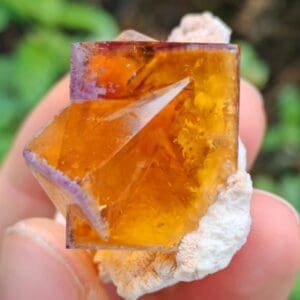Fluorite naturally occurs in all colors across the spectrum and is one of the most varied colored minerals within the mineral kingdom. Fluorite’s colors can be very intense and nearly electric. If you’re wondering if I’ll be talking about the Fluorite in your toothpaste then you’ll be sadly disappointed. Instead, I’m going to focus on some of the most popular colors and really cool specimens you’ll want to source we you go on your next buying trip.
Don’t forget that fluorite is well-known for being a fluorescent mineral which adds to its collectability.

Types of Fluorite Crystals
There are quite a few different types of Fluorite, but I’ll be covering the most popular colors and talking about the must-have specimens you need to add to your rock and mineral collection. Before you start looking through the pics and descriptions you might want to ensure you have authentic Fluorite and the best way to do that is by identifying it correctly.

Blue Fluorite
Bright blue Fluorite crystals come from several areas in France. Three particularly important localities include Le Berg, Mont-Roc, and Le Beix. Pink octahedrons were found in the Alps near the Argeniere Glacier, Chamonix, and Blanc, France. They’ve also been harvested in Uri, Switzerland.
Fine blue Fluorite crystals are also found in Spain and Germany.
These can be difficult to source but if you’re determined, you’ll find a specimen dealer selling quality pieces.

Purple Fluorite Crystal
Purple Fluorite crystals are often confused with Amethyst. The cubic crystal structure is a strong tell you’re looking at Fluorite and the gradient of purple you see in Fluorite is much greater than what you see in Amethyst.
FYI, Amethyst offers a hexagonal structure with elongated crystals containing six-sided shapes.

Rainbow Fluorite
Rainbow Fluorite is also called Fluor Spar. It’s an incredibly stunning stone that displays an incredible range of colors and is relatively affordable. Some of the most beautiful specimens are found in England, Mexico, and China. However, it was once mined in the US, in Southern Illinois.
This variety is easy to source and can be purchased as finished goods, polished slabs, or small to medium chucks.

Green Fluorite
Green Fluorite is prized by metaphysical healers, geologists, and collectors. These stones are smooth when tumbled, and they take on an incredible marbled appearance. In its natural form, green Fluorite ranges in color from light to nearly transparent green to darker jade-colored hues.
While Fluorites are available in various colors, green is among the most popular. The stone’s fluorescence was discovered in the eighteen hundreds by George Stokes. The geologist realized the stone’s ability to glow when exposed to pure white lights.
The stunning violet glow of Fluorite seems somewhat magical.

Yellow Fluorite
Yellow Fluorite crystals are usually sourced in clusters and rarely do you see single crystals. If I were you, I’d add a nice single or double crystal specimen to your collection.
Make sure you purchase crystals with decent transparency and stay away from the milky or cloudy ones. It also helps if you have a white matrix attached to the crystals because it adds a bright background for the yellow Fluorite to contrast against.
Where Is Fluorite Found?
Fluorite is often found in cavities within limestone in ore deposits and quarries. More rarely, Fluorite is found in cavities of coarse granite-type rocks, including Pegamites. It can even be found in volcanic flow rocks, like Rhyolite.
Some of the most beautiful specimens have been found in England, Mexico, and China or if you don’t want to travel internationally then you can find some amazing Fluorite crystals in Arizona, Colorado, and New Mexico.
Fluorite Streak Color
While Fluorite comes in various colors, including rainbow, all specimens produce a white streak.

Fluorite Cleavage
Fluorite has incredibly interesting cleavage habits. The perfect cleavage to the octahedral faces will sometimes be peeled off to smooth out a crystal into a perfect octahedron. Many Fluorite crystals, especially larger specimens, have sections or edges chipped off because of the cleavage.
How Is Fluorite Mined?
Fluorite is mined with the open-pit method using equipment like excavators, loaders, and dump trucks. Mining involves removing the soil and rock above the deposits (the overburden) to expose the deposits, then blasting with explosives to extract the mineral ore. Once extracted, Fluorite is transported to processing facilities for refinements.
However, underground mining methods might be used depending on the depth and quality of each deposit. Specific mining techniques vary based on the geological characteristics of the orebody.
- Identify Enstatite - March 12, 2024
- Identify Cerussite - March 3, 2024
- Identify Bytownite - February 18, 2024
